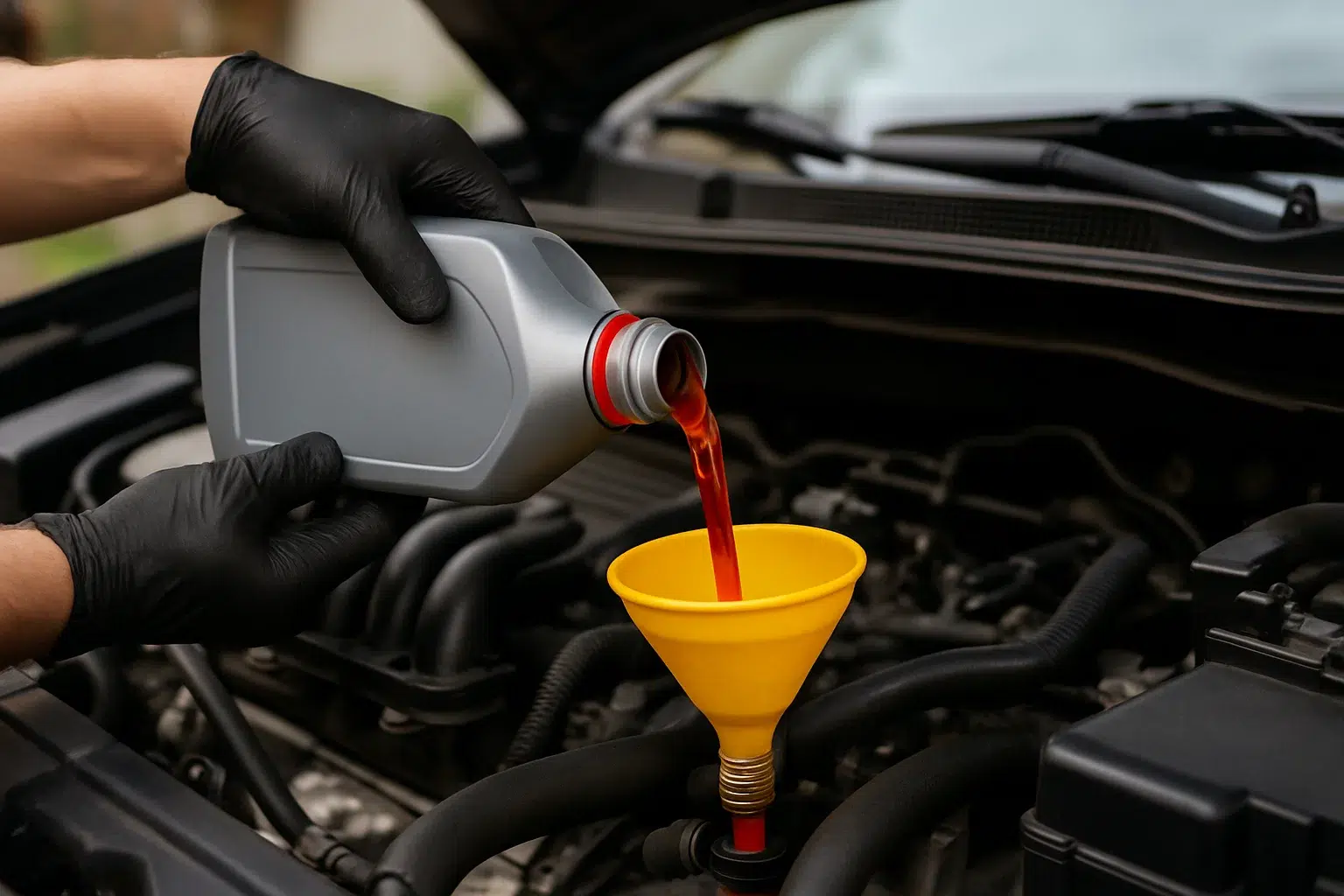Yes. For most modern automatic vehicles, the engine should be running and at normal operating temperature when checking or adding transmission fluid. This allows the fluid to circulate properly and ensures you get an accurate reading.
No. In some older cars or manual transmissions, the process can be different, and the fluid may need to be checked with the engine off. Always consult your vehicle’s owner’s manual for the exact procedure.
Why Transmission Fluid is Important
Transmission fluid is more than just a lubricant. It plays several vital roles in keeping your car’s transmission healthy:
- Lubrication – It reduces friction between gears and moving parts.
- Cooling – It prevents the system from overheating.
- Hydraulic function – It enables smooth gear shifting.
- Cleaning – It carries away debris and prevents buildup inside the transmission.
Without proper fluid levels, you may face:
- Hard or delayed gear shifts
- Slipping or jerky gears
- Overheating transmission
- Costly internal damage
Modern vehicles use different types of fluid depending on their system:
- Automatic Transmission Fluid (ATF) for most vehicles
- CVT Fluid for continuously variable transmissions
- DCT Fluid for dual clutch systems
Maintaining the right fluid level not only improves performance but also extends your transmission’s lifespan.
How to Check Transmission Fluid

Checking your transmission fluid properly is essential to prevent overfilling or underfilling, which can lead to serious transmission problems. Follow these steps:
- Park on a Level Surface – Engage the parking brake to ensure safety.
- Warm Up the Engine – Let the car reach its normal operating temperature so the fluid circulates properly.
- Remove the Dipstick – Pull out the transmission dipstick, wipe it clean, reinsert it fully, and then remove it again to check the fluid level.
- Inspect the Fluid – Healthy fluid should be reddish in color, clear, and free of debris. Burnt-smelling or dark fluid indicates it’s time for a change.
- Consult the Owner’s Manual – Some vehicles require different procedures, so always double-check your car’s specifications.
Before adding fluid, it’s important to know how to check transmission fluid correctly. Understanding fluid circulation, temperature effects, and proper measurement ensures accurate readings and prevents damage.
For a more detailed explanation of automatic transmission operations and how fluid interacts with internal components, check out the detailed guide on Automatic Transmission in Cars.
How to Add Transmission Fluid Safely
Once you’ve checked the fluid level, adding transmission fluid correctly is critical to avoid overfilling or damaging your transmission. Follow these steps:
- Locate the Fill Port – Most cars have a dipstick tube or a dedicated fill opening for transmission fluid.
- Use a Funnel or Pump – This helps prevent spills and ensures the fluid goes directly into the transmission.
- Add Fluid Gradually – Pour small amounts at a time and recheck the level frequently. Overfilling can cause foaming, erratic shifting, or overheating.
- Check for Leaks – After adding, inspect the system to ensure there are no leaks or seepage.
- Cycle Through Gears – Shift through all the gears with the car in Park to allow the fluid to circulate evenly.
Knowing how to put in automatic transmission fluid properly is essential for smooth operation and long-term reliability. Adding transmission fluid while following these precautions prevents costly repairs and ensures your car continues to run efficiently. Remember, patience is key, never rush the process.
Modern Transmission Considerations
Dual Clutch Transmission (DCT)
Vehicles with dual clutch transmissions (DCT) require precise attention to fluid levels. The system relies on dual clutches that engage and disengage rapidly to provide smooth, quick gear shifts. Using the wrong type of fluid or overfilling can cause:
- Slipping or jerky gear changes
- Premature clutch wear
- Reduced transmission lifespan
Paying attention to dct fluid is essential for reliability. Proper maintenance ensures smooth performance, prevents costly repairs, and maintains optimal fuel efficiency.
Continuously Variable Transmission (CVT)
CVT systems operate differently from traditional automatics. They use pulleys and belts to provide a seamless range of gear ratios. Using standard ATF in a continuously variable transmission can lead to severe damage, including:
- Belt slippage
- Poor performance
- Premature wear on the transmission components
Modern CVTs require careful fluid selection and periodic inspection to maintain efficiency and prevent mechanical issues. Regular checks and proper fluid levels help extend the life of these advanced systems.
Common Mistakes When Adding Transmission Fluid

Even experienced drivers sometimes make errors that can harm the transmission. Common mistakes include:
- Overfilling the transmission – Too much fluid can cause foaming, overheating, and erratic gear shifts.
- Using the wrong type of fluid – Always confirm the manufacturer-recommended transmission fluid to avoid seal or clutch damage.
- Checking fluid incorrectly – Measuring with the engine off when it should be running can lead to inaccurate readings.
- Adding fluid while not in Park or Neutral – This is unsafe and may cause fluid spillage or internal damage.
- Ignoring leaks or contamination – Dirty or leaking fluid can reduce performance and increase repair costs.
Avoiding these mistakes helps your transmission operate efficiently and extends its lifespan.
Tips for Long-Term Transmission Health
Proper maintenance is key to keeping your transmission in top condition. Here are practical tips:
- Warm up your engine before checking or adding fluid to ensure accurate readings.
- Cycle through all gears to circulate fluid fully throughout the transmission system.
- Use proper tools, such as a funnel or pump, to prevent spills.
- Inspect fluid regularly – clean ATF should be red or pink with no burnt smell.
- Schedule routine maintenance – regular servicing helps detect issues before they become serious.
Maintaining the right fluid level and following these best practices ensures smooth operation, prolongs transmission life, and prevents costly repairs.
Professional Guidance on Transmission Fluid
For accurate information on transmission fluid types, maintenance procedures, and industry standards, it’s important to consult reputable sources. Automotive professionals and certified technicians follow best practices to ensure vehicle safety and reliability.
For detailed, authoritative guidance, refer to Automotive Service Excellence – ASE. This resource provides comprehensive information on transmission systems, fluid types, and professional servicing standards.
Following trusted guidance helps avoid common mistakes, ensures correct fluid selection, and maintains optimal transmission performance.
FAQs
Do you add transmission fluid while running or off?
Most modern automatic vehicles require the engine to be running and at operating temperature when adding fluid. Some older vehicles or manual transmissions allow adding fluid while the engine is off. Always consult your owner’s manual to avoid mistakes.
How long should the car be running to check transmission fluid?
Warm up the engine to its normal operating temperature, cycle through all gears to circulate fluid, then leave the car idling in Park. This process ensures an accurate fluid level reading and proper transmission lubrication.
What is the correct way to add transmission fluid?
Use a funnel or pump to add fluid gradually. Check the fluid level frequently, avoid overfilling, and always use the manufacturer-recommended transmission fluid. This method prevents foaming, overheating, and operational issues.
Can I add transmission fluid while the car is hot?
Yes, many vehicles require the engine to be at normal operating temperature to ensure accurate measurement and proper fluid circulation. Avoid adding fluid when the system is cold, as it can give false readings and lead to overfilling.
Conclusion
Checking and adding transmission fluid correctly is critical for vehicle performance, safety, and longevity. By following proper steps, warming up the engine, using the correct fluid, and avoiding common mistakes, you can prevent costly repairs and ensure smooth operation of your transmission.
Whether your car uses a traditional automatic, a DCT, or a CVT system, proper fluid maintenance is essential for reliability and efficiency. Regular inspections, careful fluid addition, and adherence to manufacturer guidelines keep your car operating safely under all driving conditions.
For more detailed guides and expert tips on maintaining your vehicle, explore our Car Maintenance & Repairs section. This category covers a wide range of topics, from automatic transmission care to engine maintenance, ensuring your car stays in top condition.

I am Tushar Balchandani, founder of Car Info Expert and someone who has been working extensively in the car industry as a car expert for 15 years. My aim is to provide useful truthful and reliable information to the readers based on my real experiences and hands-on experience. From buying tips to maintenance guides, I help readers make confident car-related decisions.




